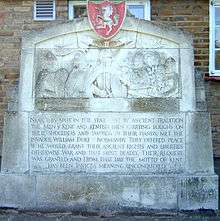Gavelkind
Gavelkind (/ˈɡævəlkaɪnd/) was a system of land tenure associated chiefly with the county of Kent, but also found in Ireland and Wales and some other parts of England. Its inheritance pattern is a system of partible inheritance, which bears resemblance to Salic patrimony: as such, it might testify in favour of a wider, probably ancient Germanic tradition. Under this law, land was divided equally among sons or other heirs.[1] The word Gavelkind is thought to have originated from old Irish phrases 'Gabhaltas-cinne' or Gavail-kinne, which means family settlement. (Modern Gaelic 'gabhail-cine'.)[2]
Over the centuries, various acts were passed to degavel individual manors but, in England and Wales, it was the Administration of Estates Act 1925 that finally abolished the custom.[3][4][5]
Gavelkind in Kent

Before abolition of gavelkind tenure by the Administration of Estates Act 1925, all land in Kent was presumed to be held by gavelkind until the contrary was proved.[6] It was more correctly described as socage tenure, subject to the custom of gavelkind. The chief peculiarities of the custom were the following:[6]
- A tenant could pass on part or all of his lands as a fiefdom from fifteen years of age.
- On conviction for a felony, the lands were not subject to corruption of blood.
- Generally the tenant could always dispose of his lands in his will.
- In case of intestacy, the estate was passed on to all the sons, or their representatives, in equal shares, leaving all the sons equally a gentleman. Although females claiming in their own right were given second preference, they could still inherit through representation.
- A dowager was entitled to one half of the land.
- A widow who had no children was entitled to inherit half the estate, as a tenant, as long as she remained unmarried.
Gavelkind, an example of customary law in England, was thought to have existed before the Norman Conquest of 1066, but generally was superseded by the feudal law of primogeniture. Its survival (until as late as 1925) in one part of the country, is regarded as a concession by William the Conqueror to the people of Kent.[7]
Gavelkind in Wales
In Wales there was a custom of inheritance similar to that of gavelkind in England which, in Welsh, was known as cyfran.[8][9]
Under Welsh common law on a landowner's death the land would be divided equally among all his sons, including illegitimate sons.[10]
The ultimately infinite division of ever smaller pieces of land by successive generations of sons has been blamed for the comparative weakness of the Welsh polity as opposed to the system of primogeniture in England where the entire patrimony was received intact by the eldest son. The Welsh historian Philip Yorke, writing in 1799, summarised the situation:
Our laws of gavelkind, had ill effect, applied to the succession as the freedom of the State; it balanced the power and raised the competition of the younger branches against the elder; a Theban war of Welsh brethren ending in family blood, and national destruction.
— Philip Yorke, The Royal Tribes of Wales, p. 46
The Laws in Wales Acts 1535–1542 saw the Welsh legal system being replaced with that of the English, and the law of gavelkind was replaced with that of primogeniture; however, as in England, the custom of gavelkind was not finally abolished until the Administration of Estates Act 1925.[5][10]
Gavelkind in Ireland
In Ireland, gavelkind was a species of tribal succession, by which the land, instead of being divided at the death of the holder amongst his sons, was thrown again into the common stock, and redivided among the surviving members of the sept.[11]
Under Early Irish law land was divided at the death of the holder amongst his sons. The Normans gave this Irish inheritance law the name gavelkind due to its apparent similarity to Jute gavelkind inheritance in Kent.[11]
Notes
- "Gavelkind". Websters Dictionary. Retrieved 24 August 2012.
- Collectanea de Rebus Hibernicus, Volume 1
- Elton. The tenures of Kent. ch. XVI – Disgavelled Lands
- Friar, Stephen (2001), The Sutton Companion to Local History (rev. ed.), Stroud: Sutton Publishing, p. 182, ISBN 0-7509-2723-2
- "Administration of Estates Act 1925. S.45 (1)". HMSO. Retrieved 24 August 2012.
- Watson, Alan (2001). Society And Legal Change (2nd Ed). Philadelphia: Temple University Press. p. 53. ISBN 1-5663-9919-X.
- R. J. Smith, "The Swanscombe Legend and the Historiography of Kentish Gavelkind," in Medievalism in the Modern World. Essays in Honour of Leslie J. Workman, ed. Richard Utz and Tom Shippey (Turnhout: Brepols, 1998), pp. 85–103.
- "National Terminology Portal: gavelkind". Bangor Uninversity. Retrieved 2 Sep 2012.
- Richards, William (1832). Welsh English Dictionary. Carmarthen. Retrieved 19 September 2012.
- Koch. Celtic Culture. Vol. 1. p. 11
- Connolly, S.J (2007). "The Oxford Companion to Irish History". Oxford University Press. Retrieved 30 August 2012.
References
- Challis, Real Property.
- Digby, History of the Law of Real Property
- Elton, Charles I. (1867), The Tenures of Kent, London: James Parker and Co
- Koch, John (2006). Celtic Culture: A Historical Encyclopedia, Volumes 1. Santa Barbara, CA: ABC-CLIO Ltd. ISBN 1-85109-440-7.
- Pollock and F. W. Maitland, History of English Law
- Yorke, Philip (1799). The Royal Tribes of Wales. Printed by John Painter.
![]()
Further reading
- Robinson, Thomas (1822), The Common-Law of Kent, London: Henry Butterworth